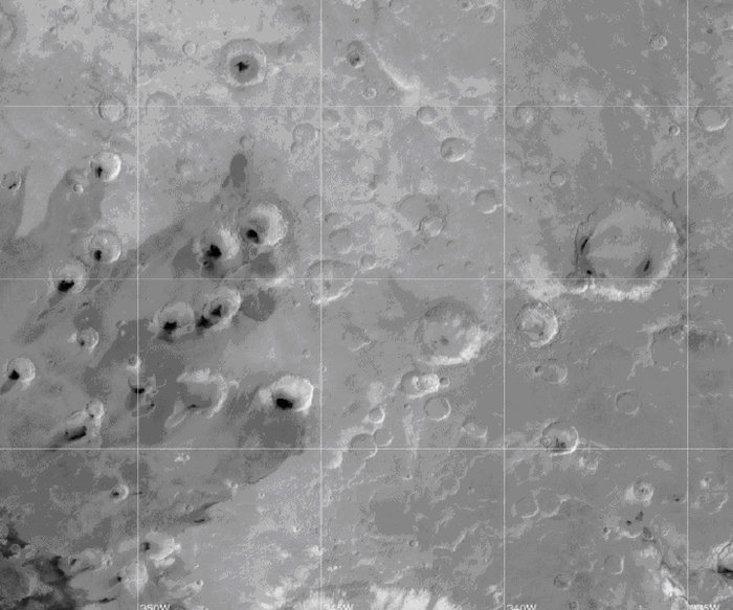
If you want to detect life on another planet, look for biomarkers—spectroscopic signatures of chemicals that betray the activity of living things. And in fact we may have already found a biomarker. In 2003 Earth-based astronomers caught glimpses of methane in the Martian atmosphere. The discovery was initially controversial, so much so that the discoverers themselves held back from publishing it. But the two of us and our colleagues recently confirmed the presence of methane using NASA’s Curiosity rover. It is the most tangible evidence we have ever collected that we may not be alone in the universe.
Almost no matter where the methane comes from, it’s an intriguing discovery. If you dropped a molecule of methane into the atmosphere of Mars, it would survive about 300 years—that’s how long, on average, it would take for solar ultraviolet radiation and other Martian gases to destroy the molecule. By rights, the Martian atmosphere should have been scrubbed of its methane eons ago. So, the methane we see must come either from a source that is producing methane today or from a subsurface reservoir that is venting methane produced sometime in the past. On Earth, 95 percent of methane is biological in origin. The class of bacteria known as methanogens feeds on organic matter and excretes methane. They populate our planet’s wetlands, which account for nearly a quarter of the methane present in the Earth’s atmosphere globally. Cows’ gut bacteria are the second largest producers. It is the possibility of microbial life that has propelled the search for methane on Mars.
But even if the methane there comes from geologic processes, it would give us a profound new respect for what looks outwardly like a geologically dead world. Methane can be produced by the geochemical process of serpentinization, which is widespread in Earth’s crust, especially at warm and hot hydrothermal vents on the ocean floor known as Lost City and Black Smokers. This process requires a source of geologic heat as well as liquid water. Those happen to be two main ingredients of life, as well.
Mars is indeed active and has the potential of harboring past or present microbial life.

The mystery isn’t just that we see methane when we shouldn’t. It’s also that, in a sense, we see too much of it. The Mars methane abundance varies dramatically in location and time, implying not only an unknown source, but also an unknown sink. The variation was evident in the very first detections from telescopes in Hawaii and Chile, reported by NASA astronomer Michael Mumma at a meeting of the Division of Planetary Sciences in 2003. The following year, Vittorio Formisano of the Institute for Interplanetary Space Physics in Rome and his team (including one of us, Atreya) published findings from the European Space Agency’s Mars Express orbiter. Like Mumma, Formisano’s team observed variations in methane abundance, although the values measured from Mars Express were much lower, about 15 parts per billion by volume (ppbv) global average. By comparison, the methane abundance on Earth is 1875 ppbv. (Gas concentrations are commonly measured by the volume a gas occupies, as opposed to its mass.)
Both sets of observations sought the infrared spectral fingerprint of methane in sunlight reflected from the Martian atmosphere. The ground-based telescopic observations looked out through Earth’s own air, which also contains methane, so the analysis had to separate the Martian and terrestrial methane signals. Although the orbital data did not suffer from this problem, they had their own confounding factors, such as the presence of other gases with overlapping spectral lines in the same region. Both teams were very careful, but their observations remain controversial to this day.
To resolve the issue, NASA decided in 2004 to dedicate an instrument on the Mars Science Laboratory mission (with its rover, Curiosity) to the methane question. The Sample Analysis at Mars (SAM) instrument package, built and operated by a team led by Paul Mahaffy of NASA, included a tunable laser spectrometer (TLS). The TLS performs an in-situ measurement of methane in a well-defined atmospheric volume of known temperature and pressure. The instrument first ingests Martian air into a cell about the size of a coffee cup. Then it fires an infrared laser into the gas to see how much light is absorbed. The laser scans across wavelengths to look for the distinctive fingerprint of methane and other gases. On its own, the TLS can measure methane to within about 2 ppbv. To achieve even higher sensitivities, SAM flows the ingested gas slowly over a compound that scrubs out the dominant carbon dioxide gas, thereby enriching the methane signals, and reducing the measurement uncertainty to about 0.1 ppbv. On Earth, the TLS technique has been used since the 1980s and produced the first airborne measurements of chlorine reservoirs in the ozone hole, the deuterium-to-hydrogen ratio in cirrus clouds, and methane measurements at numerous locations.

The instrument does have one potential source of error. In the weeks prior to launch, it is normal for a spacecraft and its instruments to be exposed to Earth’s air during assembly test and launch operations at the launch site. In our case, the instrument foreoptics chamber (through which the laser beam passes before entering the sample chamber) took in a small amount of Florida air containing Earth methane. We compensate for this contamination by taking each measurement on Mars three times. First, we pump out all the Martian air, so that the sample chamber is a vacuum; that way, the only methane we measure will be the Floridian stowaway. Then, we let in the Martian air and measure again. Finally, we again empty the sample chamber and measure once more. In this way, we can isolate and subtract the Earth contaminants. Furthermore, we have seen no sign of leakage from the foreoptics chamber over its years on Mars. Because the effect of the contaminants remains constant, they cannot account for any variation we observe.
Our instrument began its work when the Curiosity rover landed in Gale Crater on Mars in August 2012. Over a three-year period on the surface of Mars, the TLS-SAM generally observed low background levels (about 0.5 ppbv). The background levels oscillated with the Martian seasons, which was the first time that any Mars methane measurement has showed any repeatability. This background methane could have originated in comets and meteorites that crash periodically onto Mars. Or it could have come from interplanetary dust particles that flutter down to the Martian surface, bringing organic material that the sun’s ultraviolet radiation breaks down into methane. The seasonal pattern seems to correlate with the ultraviolet light flux reaching the surface and will tell us a lot about the delivery of organic material to the Martian surface.
Surprisingly, during a single two-month period, four sequential observations reported a spike of 7 ppbv. These values were much too high to explain by comets, meteorites, or dust. They must have been of Martian origin—perhaps a burp from a relatively small and localized subsurface source to the north of the landing site. The Martian winds would blow that methane away over several months, explaining why the signal went away when it did. Alternatively, that pulse could be from a distant and much bigger source, which would require some other unknown mechanism to remove methane quickly. Like the earlier observations of plumes, the spikes seen by Curiosity remain a tantalizing clue to a still-enigmatic Mars.
The methane data have shown that Mars is indeed active and has the potential of harboring past or present microbial life. But many puzzles remain, demonstrating how any potential biomarker we see will always require meticulous follow-up work. The European Space Agency’s ExoMars Trace Gas Orbiter, which reached Mars last month, includes powerful instrumentation for sensing methane, looking either straight down or at the limb of the planet when backlit by the sun. The pair of methods can measure how the abundance varies with altitude and is spread out across the planet. As Curiosity continues its near-surface measurements with ExoMars peering down from above, we will be able to answer the question: To what extent are the rover measurements representative of the whole planet? And then we can begin to understand whether we share our solar system with Martian microbes.
Sushil K. Atreya is a professor at the University of Michigan at Ann Arbor and a Distinguished Visiting Scientist at the Jet Propulsion Laboratory in Pasadena, California. A specialist on the origin and evolution of planetary atmospheres, he has worked on Voyager, Galileo, Cassini-Huygens, Venus Express, Mars Express, Mars Science Laboratory, and Juno missions.
Christopher R. Webster is the director of the Microdevices Laboratory at the Jet Propulsion Laboratory in Pasadena, California. He has pioneered the development of tunable laser spectrometers for balloons, aircraft, and spacecraft. He has led over 500 aircraft and 20 high-altitude balloon missions for Earth studies, leading up to the selection of his spectrometer for the Mars Curiosity rover.
This article was originally published on Nautilus Cosmos, in November 2016.
WATCH: The legendary film editor Walter Murch tells us what happened after the discovery of Uranus.































